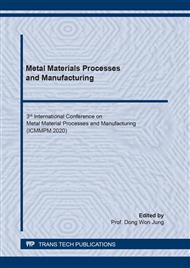[1]
Jaber E. Abu Qudeiri, Ahmad Saleh, Aiman Ziout, Abdel-Hamid I. Mourad, Mustufa Haider Abidiand Ahmed Elkaseer. Advanced Electric Discharge Machining of Stainless Steels: Assessment of the State of the Art, Gaps and Future Prospect. Materials, (2019).
DOI: 10.3390/ma12060907
Google Scholar
[2]
Ignacio Hernández-Castillo1, Orquídea Sánchez-López, Guillermo Arturo Lancho-Romero, and Cuauhtémoc Héctor Castañeda-Roldán. An experimental study of surface roughness in electrical discharge machining of AISI 304 stainless steel. IngenIería e InvestIgacIón vol. 38, No.2, pp.90-96, (2018).
DOI: 10.15446/ing.investig.v38n2.67711
Google Scholar
[3]
Le Xuan Hung, Tran Thanh Hoang and Vu Ngoc Pi. A Study on Modelling Surface Finish in Electrical Discharge Machining Tablet Shape Punches Using Response Surface Methodology. Journal of Environmental Science and Engineering B 6, pp.387-390, (2017).
DOI: 10.17265/2162-5263/2017.07.006
Google Scholar
[4]
Tran Thanh Hoang, Tran Anh Duc, Nguyen Manh Cuong, Luu Anh Tung, Le Xuan Hung, Vu Ngoc Pi. Modelling Surface Finish in Electrical Discharge Machining Tablet Shape Punches using Response Surface Methodology. SSRG International Journal of Mechanical Engineering (SSRG-IJME), vol. 4, Issue 9, pp.28-30, (2017).
DOI: 10.17265/2162-5263/2017.07.006
Google Scholar
[5]
Jiaofei Huo, Shoufa Liu, Yinwei Wang, T. Muthuramalingam and Vu NgocPi. Influence of process factors on surface measures on electrical discharge machined stainless steel using TOPSIS. Mater. Res. Express 6, (2019).
DOI: 10.1088/2053-1591/ab1ae0
Google Scholar
[6]
Rajmohan T., Prabhu R., Subba Rao G. and Palanikumar K. Optimization of Machining Parameters in Electrical Discharge Machining (EDM) of 304 Stainless Steel, International Conference on Modelling, Optimisation and Computing, (2012).
DOI: 10.1016/j.proeng.2012.06.129
Google Scholar
[7]
Seung-Han Yang, J. Srinivas, Sekar Mohan, Dong-Mok Lee, Sree Balaji, Optimization of electric discharge machining using simulated annealing, Journal of Materials Processing Technology, 209 (2009) 4471–4475.
DOI: 10.1016/j.jmatprotec.2008.10.053
Google Scholar
[8]
Ignacio Hernández-Castillo, Orquídea Sánchez-López, Guillermo Arturo Lancho-Romero, and Cuauhtémoc Héctor Castañeda-Roldán, An experimental study of surface roughness in electrical discharge machining of AISI 304 stainless steel, IngenIería e InvestIgacIón vol. 38 No. 2, august - 2018 (90-96).
DOI: 10.15446/ing.investig.v38n2.67711
Google Scholar
[9]
Y. S. Wong, L. C. Lim, Iqbal Rahuman, W. M. Tee. Near mirror finish phenomenon in EDM using powder mixed dielectric. Journal of Material ProcessingTechnology 1998; 79: 30-40.
DOI: 10.1016/s0924-0136(97)00450-0
Google Scholar
[10]
Yeo, S.H., Tan, P.C., Kurnia, W. Effect of powder additives suspended on dielectricon crater characteristics for micro electrical discharge machining. Journal of Micromechanics and Microengineering2007; 17: 91–98.
DOI: 10.1088/0960-1317/17/11/n01
Google Scholar
[11]
Chow, H.M., Yang, L.D., Lin, C.T., Chen, Y.F. The use of SiC powder in water asdielectric for micro-slit EDM machining. Journal of Materials Processing Technology2008;195:160–170.
DOI: 10.1016/j.jmatprotec.2007.04.130
Google Scholar
[12]
Gunawan, S.P., Mahardika, M., Hamdi, M., Wong, Y.S., Mitsui, K. Effect ofmicro-powder suspension and ultrasonic vibration of dielectric fluid in micro-EDM processes - Taguchi approach. International Journal of Machine Tools andManufacture2009; 49: 1035–1041.
DOI: 10.1016/j.ijmachtools.2009.06.014
Google Scholar
[13]
W. S. Zhao, Q. G. Meng, Z. L. Wang, The application on power mixed EDM in rough machining, Journal of Materials Processig Technology 129 (2002) 30-33.
Google Scholar
[14]
W. S. Zhao, Q. G. Meng, Z. L. Wang. The application of research on powder mixed EDM in rough machining, Journals of Material Processing Technology 2005; 170: 385-391.
Google Scholar
[15]
B.H. Yan, S.L. Chen. Effects of dielectric with suspended aluminium powder on EDM, J. Chin. Soc. Mech. Eng. 1993; 14(3): 307–312.
Google Scholar
[16]
B.H. Yan, S.L. Chen. Characteristics of SKD11 by complex process of electric discharge machining using liquid suspended with aluminium Powder, J. Jpn. Inst. Light Met. 1994; 58(9):1067–1072.
Google Scholar
[17]
B.H. Yan, S.L. Chen. Effect of ultrasonic vibration on electrical discharge machining characteristics of Ti–6Al–4V alloy.J. Jpn. Inst. Light Met.1994; 44(5): 281–285.
DOI: 10.2464/jilm.44.281
Google Scholar
[18]
Clijsters, S., Liu, K., Reynaerts, D., Lauwers, B. EDM technology and strategydevelopment for the manufacturing of complex parts in SiSiC. Journal of Materials Processing Technology 2010; 210: 631–641.
DOI: 10.1016/j.jmatprotec.2009.11.012
Google Scholar


